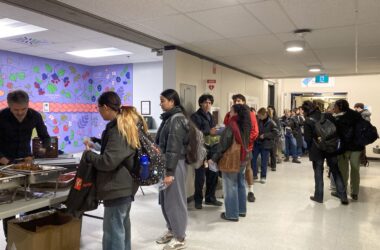On March 28, the faculty of religious studies hosted an event co-sponsored by the Canadian Christian-Jewish Consultation to discuss the question: “Do our sacred texts promote religious intolerance?” Held in the Birks Heritage Chapel, the panel featured Rabbi Lisa Grushcow, Professor of Biblical Studies Ian Henderson, and Imam Habeeb Alli, who shared how their respective experiences and religious training has shaped their views of the potential relationship between sacred texts and religious intolerance.
“Understanding the various factors that contribute to intolerance and violence among and within religious traditions is an important research question in religious studies,” Ellen Aitken, dean of the faculty of religious studies, said. “In light of the central role of scriptures and sacred texts in many religions, it is essential to explore how such texts are used not only in ways that are beneficial but also [serve] to divide and harm.”
Throughout the evening, all three scholars highlighted the particular importance of interpretation by sharing passages from sacred texts that could be read as promoting intolerance depending on the interpretation. Grushcow shared the troubling story of Phinehas in Numbers 25, Henderson discussed early Christian-Jewish relations referenced in 1 Thessalonians 2, and Alli cited some violent passages of the Qur’an used to promote intolerance, war, and even wife-beating.
“It is how we choose to read that is key,” Grushcow said. The scholars agreed that in each of the cases presented the way in which the text is read is crucial to understanding its meaning and purpose.
Henderson encouraged the audience to address sacred texts like tools.
“[Sacred texts] are intelligently designed, and thus we need to discern their purpose [in order to understand them],” he said. “These texts cannot mean anything [we] want [them] to mean.”
One English literature and religious studies student, who could only be identified as Mark, thought this metaphor was the defining moment of the night.
“I think that Professor Henderson’s idea of ‘Sacred Texts’ being collections of tools, or implements that can be used in different ways, was especially insightful,” he said. “It’s not a matter of ‘sugar-coating’ a religion to find a more humane approach within the passages of its scriptures, but rather a matter of continuing the millennial tradition of discovering different meanings in its pages.”
Alli then described his work battling religious intolerance brought about by improper interpretations of the Qur’an. He explained the dichotomy between Salafists and rationalists, and how difficult verses such as “slay them wherever ye catch them,” have often been misquoted and misused.
Throughout the night participants in the discussion came to the consensus that the question of a link between sacred texts and religious intolerance is not a simple question to answer-it is still a very prominent dilemma that members of all three faiths face. However, scholars and students alike agreed that, while we should cherish tolerance, it should not be viewed as an end goal, but rather as the start of something better.
“As a Christian, I think there [are] definitely parts of the Bible where it does seem to suggest intolerance, but I am often reminded by peers to look at the bigger picture: what does God have in mind for these people?” Victor Lam, U1 in McGill’s sustainability, science, and society program, said. “Tolerance is a first step, but in tolerating others, we must also learn to accept others.”






